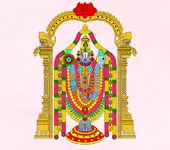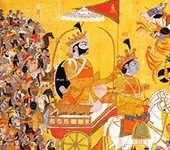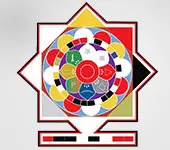Origin Of Devas, Daityas, And Danavas
Comments
Transcript
(Click here to read more)
There was imbalance between good and evil, between dharma and adharma on earth. Bhumi Devi was unable to bear the load because of this. If a load is not balanced, it will tilt towards one side and it will be difficult to carry it. We know this. Bhumi Devi complained to Brahma. Lord Vishnu assisted by Devas decided to descend upon earth and restore balance. This is behind Krishnavatara and the amshavatara of Devas such as Yudhishtira, Arjuna... When Vaisampayana told this to Janamejaya, he w....
Transcript
(Click here)
There was imbalance between good and evil, between dharma and adharma on earth.
Bhumi Devi was unable to bear the load because of this.
If a load is not balanced, it will tilt towards one side and it will be difficult to carry it.
We know this.
Bhumi Devi complained to Brahma.
Lord Vishnu assisted by Devas decided to descend upon earth and restore balance.
This is behind Krishnavatara and the amshavatara of Devas such as Yudhishtira, Arjuna...
When Vaisampayana told this to Janamejaya, he wanted to know how all the beings were created.
Now, I want to clarify something here.
In the scriptures, ten theories exist about creation.
विज्ञानेतिवृत्तवादः, सदसद्वादः, रजोवादः, व्योमवादः, अपरवादः, आवरणवादः, अम्भोवादः, अमृतमृत्युवादः, अहोरात्रवादः, दैववादः
Each one is an independent theory.
The cause of creaton, the method of creation, the form of the created universe- all these are different in each of these theories.
What is mentioned in one Purana can be different from what is mentioned in another Purana.
They are not contradictions, but they compliment each other.
We are not going into the details of this.
Here, we will stick to what is mentioned in Mahabharata.
Brahma had six manasa putras, six mind born sons.
Now here also the number varies from Purana to Purana.
Six, seven, eight, nine.
They are not errors, they are not contradictions.
According to Mahabharata, Mareechi, Atri, Angira, Pulaha, Pulastya and Kratu are the mind born sons, manasa putras.
What is the meaning of manasa putra?
They are not bilogical sons born out of male-female union.
When Brahma just thinks that I want to have a son and a son is born.
He is a manasa putra.
Then there are sons born from Brahma's organs.
Daksha was born from Brahma's right thumb.
Then there are sons born from Brahma's actions
Jambavan was born when Brahma yawned.
Kashyapa was Mareechi's son.
Most of the living beings, movable and immovable were born from Kashyapa.
Kahyapa's wives are all daugters of Daksha.
Here also there are variations about their number and whom they married.
Puranas also talk about rebirths of Daksha and different daughters in each birth.
Here according to Mahabharata they were thirteen in number.
Their names are- अदिति, दिति, दनु, काला, दनायु, सिंहिका, क्रोधा, प्राधा, विश्वा, विनता, कपिला, मुनि, and कद्रू
Kadru and Vinata, we have already seen.
Kadru is the mother of all serpents.
Vinata is the mother of Garuda and Aruna.
It is the descendents of these Daksha kanyas or daughters of Dakshas, most living beings are.
I am saying most living beings because vamashas origiated from the manasa putras thmeselves also inndependently.
All these forefathers are called Prajapatis, the progenitors.
Kashyapa Prajapati, Daksha Prajapati.
Now let us look at the descendents of the daughters of Daksha.
Aditi had twelve sons.
They are called Adityas.
Their names are- Dhata, Mitra, Aryama, Indra, Varuna, Amsha, Bhaga, Vivaswan, Pusha, Savita, Tvashta and Vishnu.
They are twelve aspects of the Sun, Suryadeva.
Like Indra is the ruler aspect, Pusha is the nourishing aspect, Savita is the creator aspect, Twashta gives specific forms to the beings, Vishnu is the protector aspect.
Vishnu is the youngest among Aditi's sons but also the most versatile and skillful.
Don't confuse this Vishnu with Paramatma Vishnu.
This Vishnu is an amsha of Paramatma Vishnu.
Diti had only one son, Hiranyakashipu.
Hiranayakashipu had five sons- Prahrada, Samhrada, Anuhrada, Shibi, and Bashkala.
Prahrada you know, Prahlada; they are the same.
Prahlada had three sons- Virochana, Kumbha, and Nikumbha.
Bali Chakravarthy was Virochana's son.
Bali's son was Banasura, the great Shiva devotee also known as Mahakala.
Being the descendents of Diti, they are collectively called Daityas.
Now, the third daughter of Daksha, Danu.
Danu had thirty four sons.
They and their descendents are collectively called Danavas.
Diti's descendents Daityas.
Danu's descendents Danavas.
The eldest among the Danavas was Viprachitti.
Another important name among the Danavas is Puloma.
He is Indra's father-in-law.
There was a Surya and Chandra among the Danavas also.
Ten Vamshas of the Danavas became famous-एकाक्ष, मृतपा, प्रलम्ब, नरक, वातापी, शत्रुतपन, शठ, गविष्ठ, वनायु, दीर्घजिह्व
At this stage, Mahabharata doesn't picturize the Daityas and Danava as demons.
Rather, Mahabharata desribes them as famous, powerful and valorous.
We will continue with the vamshas of the rest of the daughters of Daksha in the next episode.
Recommended for you
Meaning of Sri Venkatesha Suprabhatam- Part 1
 Click here to know more..
Click here to know more..
Mahabharata Can Purify Your Mind

This discourse which is part of Mahabharata series tells you about- 1. How Mahabharata purifies your mind. 2. How the central theme of Mahabharata is ....
Click here to know more..Navagraha Karavalamba Stotram

ketoshcha yah' pat'hati bhoori karaavalamba stotram sa yaatu sakalaamshcha manorathaaraan.....
Click here to know more..
English Topics
Mahabharatam
Click on any topic to open
- 96 Two Curses That Worked against Karna
- 95 What is behind Calling the Five Brothers the Pandavas
- 94 Give up an Individual IF....
- 93 Fascinating Birth Story of the Kauravas
- 92 Overcoming Grief - Lessons from King Senajit's story
- 91 Yayati's Wisdom
- 90 Yayati's Story
- 89 Brahmacharis Can Bless And Curse
- 88 Human Nature - Comples Mix Of Good And Bad
- 87 Results Of Good Karma
Please wait while the audio list loads..
30
Ganapathy
Shiva
Hanuman
Devi
Vishnu Sahasranama
Mahabharatam
Practical Wisdom
Yoga Vasishta
Vedas
Rituals
Rare Topics
Devi Mahatmyam
Glory of Venkatesha
Shani Mahatmya
Story of Sri Yantra
Rudram Explained
Atharva Sheersha
Sri Suktam
Kathopanishad
Ramayana
Mystique
Mantra Shastra
Bharat Matha
Bhagavatam
Astrology
Temples
Spiritual books
Purana Stories
Festivals
Sages and Saints
